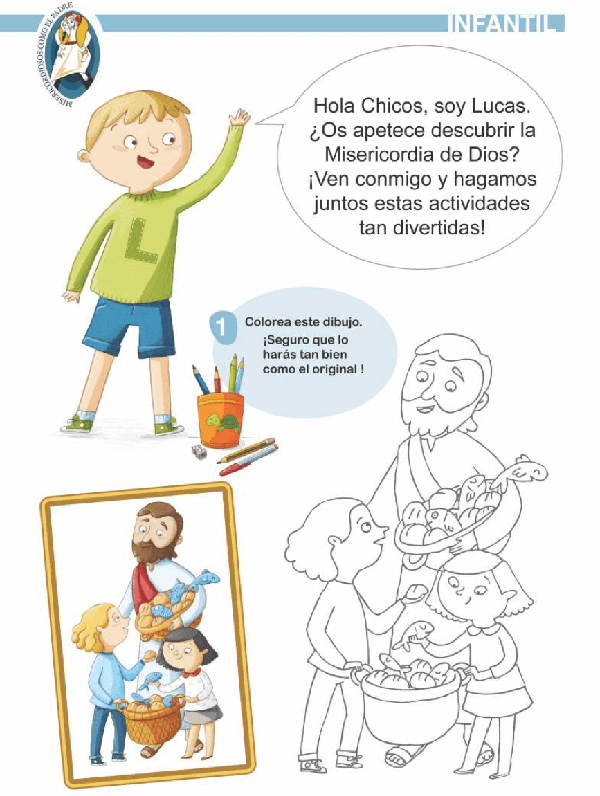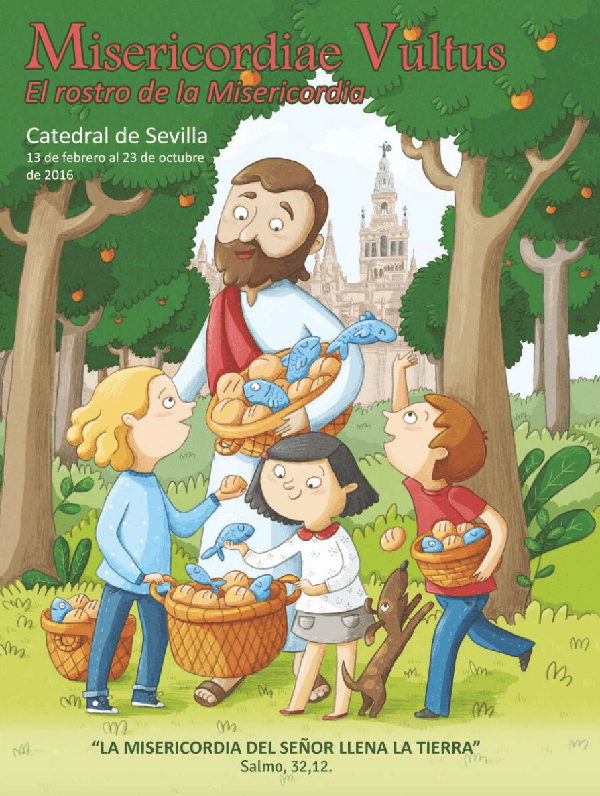
IN THIS SECTION:
Catechesis on Mercy


ILLUSTRATED CATECHESIS ON MERCY
The general objectives of the teaching material are the same as those of the overall exhibition project.
In the case of the adaptation of the contents to children, and therefore to people with intellectual disabilities, they have required the illustrative support to the accompanying texts. In this way, we intend to show the greatness of God and his infinite Mercy, seeking a parallelism between the Holy Scriptures – and the iconographic representation of them in the exhibition – and a context of current life in which it is easy for children to recognize that God is among us in every gesture, and in every experience of life.
Our work encompasses two types of support materials:
- Tri-fold brochure with inner flap that generates 6 zones.
- Cover.
- Interior space with three areas.
- Back cover with inside flap.
- Teaching material that can be worked on outside the classroom
- Mainly in schools.
- Also in the family – to generate a climate of union within the most generous community of love and conditional surrender.
- The same applies to catechetical groups.
Both materials share illustrations, which have been laid out in a different layout to achieve our purpose. The same elements and protagonists, in isolation, have been used to illustrate the teaching material with various activities.
The elaboration of the drawings, in charge of Dña. Adriana Santos Sánchez, has been carried out under a series of previous criteria:
- They are starred by children of today’s world so that our little ones can identify with a reality known to them.
- They are in line with some recognizable elements in the exhibited works.
- They are decorated with elements of nature and animals as a script to Pope Francis’ first encyclical letter on climate change and the environment. Because God’s mercy is infinite and reaches the whole earth and not only man and children taking care of their natural environment, they perform a great act of merciful love (Observe the vignette of “Correcting the one who is wrong”.
- They represent, among other illustrative components:
- To God through his son Jesus with a close and friendly countenance.
- Mary in protective attitude as MATER AMANTJSIMA (in her image are represented all the Virgins of the exhibition).
- El ¡ángel de la Guarda (allusive to the pictorial work of Murillo, XVII century).
- The figure of St. Angela of the Cross as an example of merciful dedication to others.
- The Tenebrario (allusive to this liturgical piece of furniture of the XVI century).
- The Bible of Pedro de Pamplona (allusive to this 13th century codex on display).
- Chalice of the Grapes (donated by Cardinal Diego Hurtado s. XVI).
- Baptismal font (made of marble s. XVI).
- They include the meaning of the transitional and introductory texts to the zones based on point 6.2 described in the project:
- The Sacraments (Baptismal font).
- God’s Mercy Fills History (Selected Works of Mercy on inside pages).
- Jesus Christ, the face of God’s Mercy (Cover “Multiplication of Loaves and Fishes”).
- The Church as an instrument of the divine Mercy (Portada with Giralda and Cathedral – Iglesia de Iglesias – in the background).
- MATER MISERICORDIAE (Mary teaching us to pray while caressing us as a sign of maternal protection, Marian symbols – the mirror, the crescent moon, the swallow, the lilies, … on inside pages).
- An appeal to your conscience (Works of Mercy, the example of unconditional surrender of St. Angela of the Cross).
DESCRIPTION OF THE TRIPTYCH
1.- Cover
The cover carries the name of the exhibition as the headline and underneath in a smaller subtitle: “THE MERCY OF THE LORD FILLS THE EARTH” extracted from the Letter of our Archbishop of Seville to guide the pastoral course 2015-2016.
- The illustration is dedicated to the Miracle of the Multiplication of Loaves and Fishes (John 6:1-15).
- The choice of this fact is based on the memory that abundance is a characteristic of authentic love. In a way we like to know that Jesus can perform wonders where there is not enough. Many times we think that our problems have no solution, but God does not move and, in spite of our many or few virtues, our achievements, triumphs but also our falls and failures, it is enough that we open ourselves completely to Jesus and give Him everything we have, be it little or much, so that He will take care of it. Children will recognize this scene easily.
2.- Fold-out back cover with inside folding
The Back Cover depicts the Old Testament passage The Creation of the World, iconographically represented in the pictorial works of Simon de Vos, s. XVII “The Creation of the World” and “The Creation of Adam”, included in the exhibition and which we merge into a ˙nica illustration.
- The choice of this passage is intended to collect the two parts of the Christian Bible, not only the New, but also the Old Testament; in this case Genesis 1 and 2.
- God is Love, as St. John reminds us (John 4:8 and 4:16). Out of love he created the universe; out of love he brought forth life; out of love he has allowed man to exist; children will understand with this illustration that out of love today God allows us to dream and laugh, to sigh and pray, to work and have a moment of rest.
- Childhood represents the state of innocence, grace and friendship with which God created Adam and Eve before the original sin. It is intended, with this illustration, that children understand the mercy of this condition of naivety and candor that we must maintain in our lives beyond childhood. Man was the noblest creature that God created on earth and our works of life should make us proud with the same enthusiasm with which God contemplated his creation.
3.- Inside pages
The three interior spaces have been dedicated to the distribution of the various works of mercy that can help children understand the meaning of the Jubilee. The illustrations are arranged around the drawing of the baptismal font, from which the Holy Spirit drinks, in relation to the work of the Chapel of Baptism included in the exhibition.
A total of 6 illustrations are shown, framed as if they were paintings, as a nod to the exhibition. The background is in blue as a symbol of Mary and the footprints of the shoes indicate the path of life towards the Mystery of God through a journey through His Mercy (also allusive to the journey of the exhibition itself).
Each illustration has a brief explanatory text and inside, against the background of the baptismal font, there is a more important text on the meaning of Mercy.
Some of the drawings concentrate, in one drawing, different messages of works of Mercy. Graphically it was not possible to include them all separately if we wanted to guarantee a minimum size that would make them recognizable at the level of quality we were looking for.
The work “Visiting the prisoner”, ˙nly has been suggested at a symbolic level (represented in the figure of a bird in a cage) so as not to show visibly to children such a realistic scene.
The work “Burying the Dead” has been omitted for the same reason, but it is included in the concept “Praying for us and for those who are in Heaven”.
DESCRIPTION OF THE TEACHING MATERIAL
A material has been developed with activities for students divided into three levels:
- Children.
- Primary.
- Secondary.
This material is available for download on the Exhibition website. The schools will be informed of its existence, as well as the procedure to win the Jubilee, through the attached letter.
The activities, illustrated with the characters and elements of the triptychs, incorporate elements of some of the works that make up the exhibition. They have been specifically adapted for the three academic levels and are complemented by photographs at the secondary level.
The suitability of the proposed activities has been confirmed by the Gabinete Pedagógico de Bellas Artes de Sevilla, through its Coordinator Mr. Juan Luis Ravé.
Both the images and the texts are accessible for the understanding of people with intellectual disabilities, having been certified by the Training Director of the Albatros Andalucía Association, Dña. María José García Urbina, after the professional assessment of her psycho-pedagogical team.
Raquel Liñán Martín,
Cathedral Chapter of Seville.